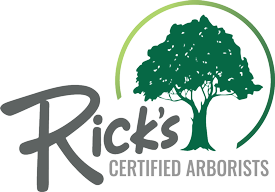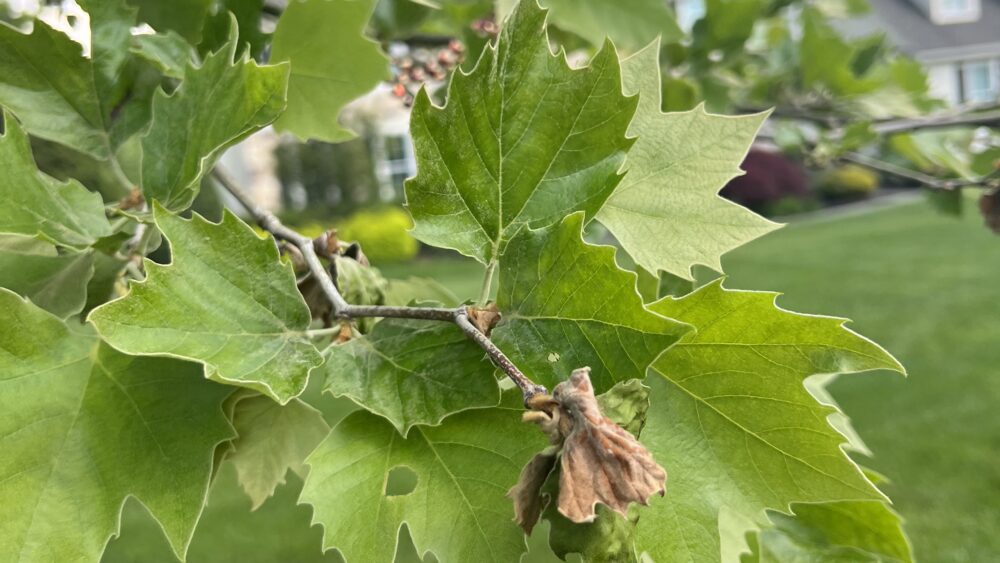Sycamore Anthracnose is a fungal foliar disease affecting American Sycamores, London Plane Trees, and Oriental Plane Trees. Call Rick’s PHC Certified Arborists at 610-840-2655 if your Sycamores or Plane Trees are not leafing out correctly.
What is Sycamore Anthracnose?
Caused by a fungal pathogen called Apiognomonia veneta, the disease kills new shoots, leaves, and buds. Trees appear distressed or dead.
Symptoms
The fungal disease causes new leaves to turn brown and fall prematurely. The darkened leaves give the disease its name: Anthracnose means “coal” in Greek. Frequently, homeowners blame the leaf damage on frost.
Shoots and buds also feel the disease’s effects. The disease is at its worst in cool, wet spring weather when the spores germinate and the pathogen spreads.
After the initial leaf loss, the tree sometimes rallies and produces a second crop of leaves. The tree may also develop cankers, leading to the dieback of twigs and larger branches.
While Sycamore Anthracnose is generally not fatal to the tree, it can cause up to 90 percent of new shoots to die. Repeated disease cycles weaken the tree and make it easier to contract secondary infections and insect infestations. They also make the tree look abnormal.
Treatment
Treatment involves a combination of sanitation and pruning. Keep the area around the trees clear of fallen leaves and twigs.
Ensure the trees experience as little stress as possible—water well in dry winters. Protect them from injury and poor nutrition.
Trees also need to be pruned properly to treat Sycamore Anthracnose. Prune the dead branches and trim the tree to avoid excess moisture collection.
Disinfect pruning shears between each cut with a 10 percent bleach solution.
Prevention
A Certified Arborist can inject or spray preventive fungicides. These fungicides may include a Bordeaux mixture (lime and sulfur) or Daconil. The Arborist must apply these preparations before the tree’s new leaves appear for it to be effective.
Many types of Oriental and London Plane Trees carry resistance to Sycamore Anthracnose. These include the Bloodgood, Columbia, and Liberty varieties. Homeowners may wish to consider planting these trees instead of Sycamores.
Are You a Good Candidate for Sycamore Anthracnose Treatment?
Sycamore Anthracnose is treatable and usually does not kill trees. However, it may negatively affect their appearance. If you have noticed that the leaves on your Sycamore or Plane Trees are withering before their time, ask a Certified Arborist what they can do to help your tree return to health.
Why Choose Rick’s PHC Certified Arborists?
Our Certified Arborists know Pennsylvania trees, and they are ready to answer your questions. Our expert services save many trees, and we dedicate ourselves to learning more about tree wellness.
Frequently Asked Questions About Sycamore Anthracnose
Here are several questions and answers about this tree disease:
What weather conditions make this disease spread?
The disease thrives in damp weather, around 50 to 55 degrees Fahrenheit. When temperatures hover in this range, the disease spreads quickly.
Is Sycamore Anthracnose largely cosmetic?
Some growers take this disease less seriously because it does not generally kill trees. However, it greatly damages their appearance and can lead to secondary infections by weakening the trees.
What does a tree infected with Sycamore Anthracnose look like?
After a few years of repeat infections, Sycamore and Plane Trees may have multiple dead branches. They may exhibit angled, irregular branches. They may have epicormic sprouts (“suckers” or “witches’ brooms”) where new growth has tried to appear along the trunk.
Will my trees recover from this disease?
If you call a Certified Arborist to treat your trees, they have an excellent chance of recovery. The irregular branches and “witches’ broom” will be lasting reminders of the infection. However, your tree should have a long life ahead.
Do I need to burn infected material from the tree?
Yes, it would be best if you burned or destroyed the pruned branches and raked leaves to prevent the fungus from overwintering in them.
Can other trees also contract Anthracnose infections?
Trees like Ash, Birch, Elm, Black Walnut, Dogwood, and Oak can also be susceptible to Anthracnose. However, these trees have their own fungal vectors and will not catch the disease from your Sycamores.
Call Rick’s PHC Certified Arborists
Call Rick’s PHC Certified Arborists at 610-840-2655 for help. Our Certified Arborists study tree diseases common in Pennsylvania and can recommend treatments and preventive actions to keep your landscape looking its best.


Comments are closed.